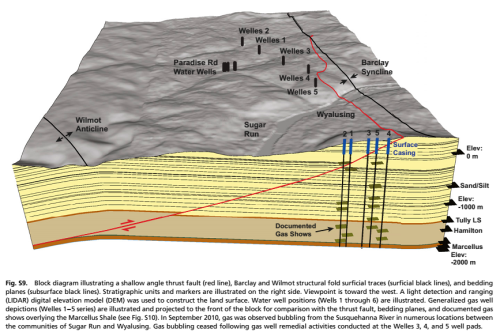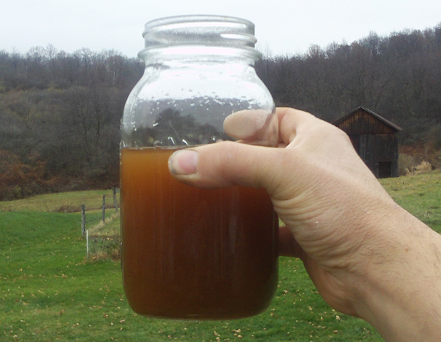New Look at BTEX: Are Ambient Levels a Problem?
May 8, 2015Emissions From Natural Gas Wells May Travel Far Downwind
May 13, 2015Evaluating a Groundwater Supply Contamination Incident Attributed to Marcellus Shale Gas Development
Download the full study as a pdf
Read more on this story in the New York Times
Introduction
High-volume hydraulic fracturing (HVHF) has revolutionized the oil and gas industry worldwide but has been accompanied by highly controversial incidents of reported water contamination. For example, groundwater contamination by stray natural gas and spillage of brine and other gas drilling-related fluids is known to occur. However, contamination of shallow potable aquifers by HVHF at depth has never been fully documented. We investigated a case where Marcellus Shale gas wells in Pennsylvania caused inundation of natural gas and foam in initially potable groundwater used by several households. With comprehensive 2D gas chromatography coupled to time-of-flight mass spectrometry (GCxGC-TOFMS), an unresolved complex mixture of organic compounds was identified in the aquifer. Similar signatures were also observed in flowback from Marcellus Shale gas wells. A compound identified in flowback, 2-n-Butoxyethanol, was also positively identified in one of the foaming drinking water wells at nanogram-per-liter concentrations. The most likely explanation of the incident is that stray natural gas and drilling or HF compounds were driven ∼1–3 km along shallow to intermediate depth fractures to the aquifer used as a potable water source. Part of the problem may have been wastewaters from a pit leak reported at the nearest gas well pad—the only nearby pad where wells were hydraulically fractured before the contamination incident. If samples of drilling, pit, and HVHF fluids had been available, GCxGC-TOFMS might have fingerprinted the contamination source. Such evaluations would contribute significantly to better management practices as the shale gas industry expands worldwide.

Shows how natural gas and other contaminants migrated laterally through kilometers of rock at shallow to intermediate depths, impacting an aquifer used as a potable water source.
Significance
New techniques of high-volume hydraulic fracturing (HVHF) are now used to unlock oil and gas from rocks with very low permeability. Some members of the public protest against HVHF due to fears that associated compounds could migrate into aquifers. We report a case where natural gas and other contaminants migrated laterally through kilometers of rock at shallow to intermediate depths, impacting an aquifer used as a potable water source. The incident was attributed to Marcellus Shale gas development. The organic contaminants—likely derived from drilling or HVHF fluids—were detected using instrumentation not available in most commercial laboratories. More such incidents must be analyzed and data released publicly so that similar problems can be avoided through use of better management practices.
Conclusions
We used comprehensive GCxGC-TOFMS to document that organic compounds derived from one or more shale gas wells in PA were the likely cause of foaming and a complex suite of UCMs in three homeowner wells. In one well, 2-BE was positively identified and is a common constituent of both HVHF and drilling fluids. These impacts were likely caused by drilling or HVHF fluids used in the gas wells. Two of the closest shale gas wells were hydraulically fractured by the time of the impact, and the well pad was cited by the PADEP for a pit leak. Despite noticeable white foaming of groundwater, reported concentrations for dissolved organics were below applicable regulatory standards when investigated by both environmental consultants and the PADEP. Only natural gas was previously reported as a confirmed contaminant. If contaminants entered groundwater during HVHF or drilling, then they persisted 2.5 y in the subsurface, i.e., until the November 2012 sampling.
Importantly, the techniques we needed to identify the impacts, GCxGC-TOFMS and GCxGC-HR-TOFMS, are not readily available in most commercial laboratories. Investigating gas drilling impacts with these analytical methods may be more effective than using target compound lists that may or may not include appropriate analytes and appropriate laboratory detection limits.
Although much of the concern shown by the public focuses on the possibility that some of the 1,000 compounds (29, 33) used in HVHF could migrate upward from the target shale, such upward leakage has never been documented. This is probably because HVHF fluids remain trapped in deep rock strata. However, the public cannot ascertain the cause of most shale gas-related problems (10) because the full datasets are often not released publicly and explained.
The data released here do not implicate upward flowing fluids along fractures from the target shale as the source of contaminants but rather implicate fluids flowing vertically along gas well boreholes and through intersecting shallow to intermediate flow paths via bedrock fractures. Flow along such pathways is likely when fluids are driven by high annular gas pressure or possibly by high pressures during HVHF injection. Such shallow- to intermediate-depth contaminant flow paths are not limited to HVHF but rather have been previously observed with conventional oil and gas wells. As shale gas development expands worldwide, problems such as those that occurred in northeastern PA will only be avoided by using conservative well construction practices, such as intermediate casing strings, proper cementation, and mitigating overpressured gas well annuli.



